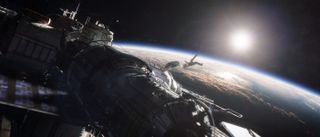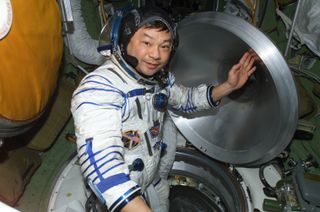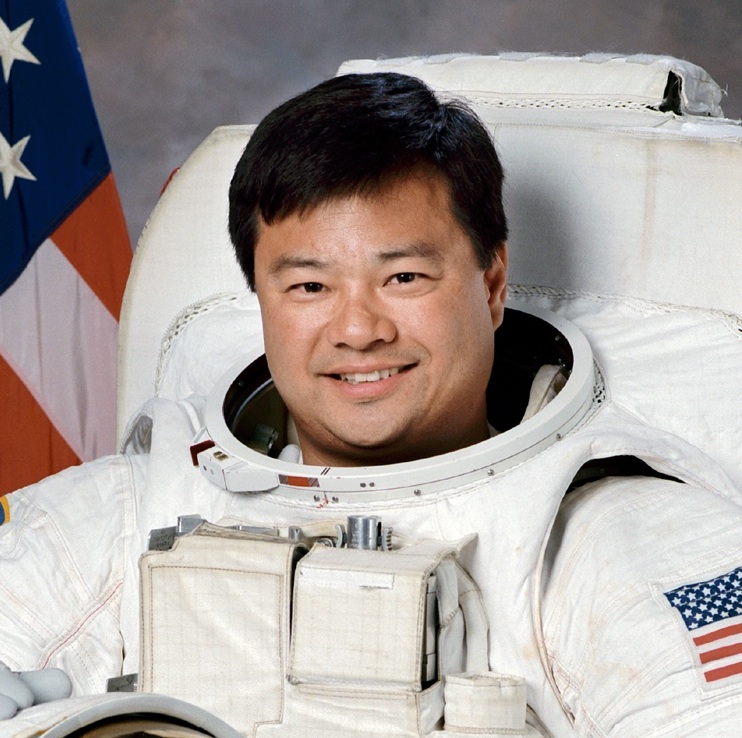
Astronaut Leroy Chiao: 'Gravity' Works, If You Don't Focus on the Physics (Op-Ed)

Leroy Chiao is a former NASA astronaut and commander of the International Space Station. During his 15-year flying career, he performed six spacewalks. Chiao is the special adviser for human spaceflight to the Space Foundation, and holds appointments at Baylor College of Medicine and Rice University. Chiao contributed this Op-Ed to SPACE.com's Expert Voices: Op-Ed and Insights.
The story at the heart of the new film "Gravity" plays upon the biggest secret fear of a spacewalker: Becoming untethered from the vehicle and tumbling away to a slow, terrifying death. The film is a drama, designed to connect with your fears and emotions, and a story of survival that reveals what it is in each person that drives us to do what we do.

Let me start by saying that "Gravity," as most of us in the business expected, is full of big inaccuracies, starting with Sandra Bullock and George Clooney, who are way too good-looking to be astronauts. I enjoyed the film, but if viewers will set aside, for 90 minutes, the big technical and operational inaccuracies (of which there are many), they will be entertained. [See photos from the film "Gravity"]
The film's creators actually did a lot of homework on the hardware, and used enough correct details to convey a framework for the story with the right look and feel of space, even if the physics, at times, are totally wrong. The special effects of creating a space environment (views of the Earth, the lighting from the sun) were also quite well done, adding to a realistic look and feel of being in space. But the story is what this film is about.
The film begins with astronauts Ryan Stone (Sandra Bullock) and Matt Kowalski (George Clooney) on a spacewalk. Suddenly, orbital debris destroys the space shuttle and sends them both tumbling off into space. Kowalski is able to reach Stone, since he is wearing a manned maneuvering unit (MMU) jet pack, and he tethers the two of them together. The two then begin using their wits to piece together some way in which they might survive this catastrophe.
Most space films are technically inaccurate. But, without these inaccuracies, the movies would not work. Take "Star Wars," for example. Fighters whooshing around in space making noise as they "fly," in graceful arcs, as if they were winged vehicles flying in an atmosphere — it's about as technically inaccurate as you can get. Yet, it was a great film, made more so by those depictions.
Keeping that in mind, I feel obliged to point out the bigger technical and operational inaccuracies of this film (this list is, by no means, all-inclusive):
Get the Space.com Newsletter
Breaking space news, the latest updates on rocket launches, skywatching events and more!
First, the orbital debris "chain reaction" that causes all of the problems is not credible. China shot down a satellite in 2007, causing a debris cloud. There was no chain reaction. In 2009, a defunct Russian satellite struck an active Iridium satellite in the first confirmed orbital debris destruction of a spacecraft. No chain reaction occurred then, either.
Second, the orbits and orbital mechanics are totally wrong in most of the scenarios that the movie depicts. The Hubble Space Telescope (HST) and the International Space Station (ISS) are in totally different orbital inclinations. China's anticipated Tiangong station is planned to be in yet a third orbital inclination. No existing or anticipated spacecraft would have nearly enough fuel to fly between those three vehicles.

Third, the MMU does not carry anywhere near the fuel, or have anywhere near the thrust, required to do the things that the movie depicts. The unit, never recertified after the Challenger accident, was mostly an experiment. It had only a limited operational capability.
Fourth, the astronauts would not be able to see the other spacecraft, the orbital debris or each other after such an accident — especially if they were tumbling out of control.
Fifth, existing spacecraft are depicted with hatches and other controls that are in the wrong places.
And finally, there is no way to enter an airlock from the outside, unless it had already been prepared for such an entry. The inner hatch would have to already be sealed.
On an emotional level, "Gravity" works. "Gravity" is a thriller that, at points, made me gasp — and I'm an astronaut. It taps into primal fear and perseverance. If you can't get beyond the gross technical inaccuracies, you will hate this film. But, if you can, "Gravity" is a thriller that will make you think about yourself and of what you are made.
Who knows? Maybe flying Sandra Bullock and George Clooney are what NASA needs in order to get people interested in the real space program.
As my first review for SPACE.com, I'm giving "Gravity" a rating of 3.5 out of 5 stars.
The views expressed are those of the author and do not necessarily reflect the views of the publisher. Follow us @Spacedotcom, Facebook and Google+. Original article on SPACE.com.
Join our Space Forums to keep talking space on the latest missions, night sky and more! And if you have a news tip, correction or comment, let us know at: community@space.com.
Leroy Chiao is a former NASA astronaut and International Space Station (ISS) commander. Chiao holds appointments at Rice University and the Baylor College of Medicine. Chiao has worked extensively in both government and commercial space programs, and has held leadership positions in commercial ventures and NASA. Chiao is a fellow of the Explorers Club, and a member of the International Academy of Astronautics and the Committee of 100. Chiao also serves in various capacities to further space education. In his 15 years with NASA, Chiao logged more than 229 days in space, more than 36 hours spent in Extra-Vehicular Activity (spacewalks). From June to September 2009, he served as a member of the White House appointed Review of U.S. Human Spaceflight Plans Committee, and currently serves on the NASA Advisory Council. Chiao studied chemical engineering at the University of California, Berkeley, earning a Bachelor of Science degree in 1983. He continued his studies at the University of California at Santa Barbara, earning his Master of Science and Doctor of Philosophy degrees in 1985 and 1987. Prior to joining NASA in 1990, he worked as a research engineer at Hexcel Corp. and then at the U.S. Department of Energy's Lawrence Livermore National Lab. Dr. Chiao left NASA in December, 2005 following a 15-year career with the agency. Chiao studied chemical engineering at the University of California, Berkeley, earning a Bachelor of Science degree in 1983. He continued his studies at the University of California at Santa Barbara, earning his Master of Science and Doctor of Philosophy degrees in 1985 and 1987. Prior to joining NASA in 1990, he worked as a research engineer at Hexcel Corp. and then at the U.S. Department of Energy's Lawrence Livermore National Lab.

